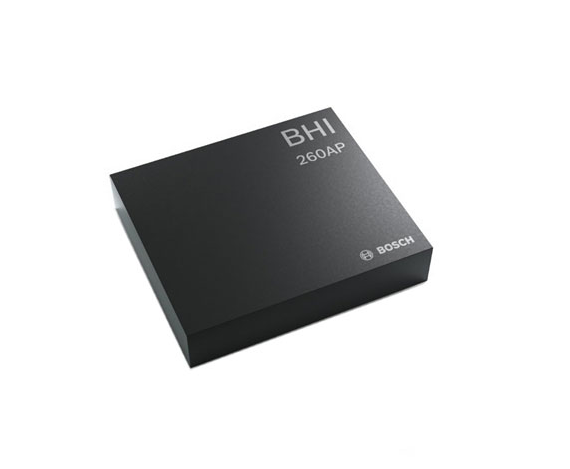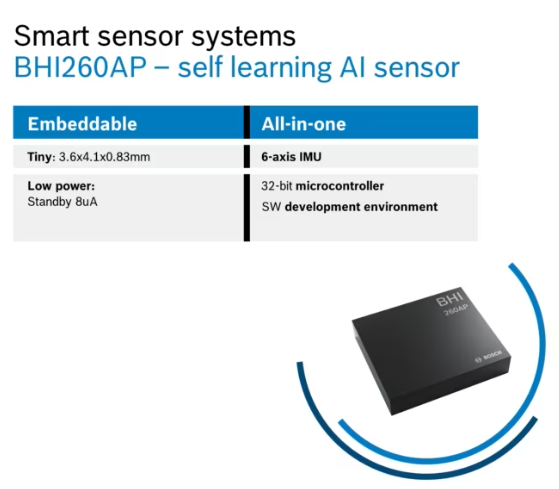
Founded in 1886, Bosch is a large company that has long focused on automotive MEMS sensors, setting up a department dedicated to the production of automotive MEMS sensors, and has its own in-house technology and fabs. Bosch has been a pioneer in MEMS since 1995 and a market leader in sensors for automotive and consumer electronics.
Bosch Sensortec, founded in 2005, holds a leading position in the consumer MEMS sensor market, and currently, Bosch Sensortec's sensors are used in approximately three quarters of the world's smartphones. Bosch Sensortec is a wholly owned subsidiary of Bosch, so they can draw on the technical capabilities and manufacturing strengths of the entire group to focus on the consumer electronics sector.
Bosch Sensortec's main product portfolio is: inertial motion sensors, such as accelerometers, gyroscopes, geomagnetic sensors, etc.; Environmental sensors, such as atmospheric pressure sensors, humidity sensors, gas sensors, etc.; Optical sensors, such as light-driven systems, a projection and scanning system mounted into smart glasses; As well as the latest layout in the acoustics field, its acquired company is developing a miniature speaker for true wireless in-ear headphones.
What are smart sensors and what can they be used for?
Smart sensors are sensors with information processing functions. Dr. Finkbeiner demonstrated the basic structure of smart sensors with an example composed of MEMS accelerometers, MEMS gyroscopes, ASics, and MCUS. "This is what we call a smart sensor, and of course we also run software on this sensor." For example, we run applications on this sensor, and we also run AI on these types of sensors, "he explained." Inside the sensor is the intelligence from the measurement ASIC and the built-in MCU and software, and they can make their own decisions."

Smart sensors can connect to a network, such as Wi-Fi in a house, through which they can communicate, collaborate, and exchange data with cloud systems. At the same time, because of its internal ASIC and MCU, the sensor can directly run software and artificial intelligence algorithms to have localized information, that is, edge AI. This not only protects personal privacy information such as body data, sports data, health status, etc., but also enables real-time fast decision making, and because the calculation is performed locally, the sensor can reduce the amount of data transmitted to the network or cloud, thereby saving battery life.
Dr. Finkbeiner explains: "If we look at the history of sensors, we started a few years ago with classical sensors, which are sensors that provide pure raw data sensor signals, for example, freely accessible accelerometers that provide X, Y and Z direction acceleration sensor signals, and this has evolved to have some applications that we call evaluation. Simultaneous evaluation means that we already have applications running on smaller MCUS or state machines that can then provide relevant information, such as step counting and real-time dynamics. In addition to these applications that apply specific software, we can also put artificial intelligence algorithms on these devices to make them more intelligent."
Smart sensors and the future
Dr. Finkbeiner then elaborates on the relationship between smart sensors and safety, health and sustainability through three practical product use cases.
BHI260AP self-learning AI intelligent sensor
The BHI260AP is a self-learning AI sensor for wearables, ear devices, and smart homes that integrates 6-axis inertial sensors, 3-axis accelerometers, 3-axis gyroscopes, ASics, 32-bit programmable MCUS, and software capabilities in a single system-level package (SiP) solution. The package size is only 3.6x4.1x0.83mm³. The smart sensor provides embedded edge AI using self-learning AI software, including fitness tracking, navigation, machine learning analytics, and relative and absolute direction estimation.

The BHI260AP's unique self-learning and personalization capabilities enable users to easily train their equipment with customized fitness activities. The sensor contains more than 15 pre-learned fitness activities, so no training is required before use. In addition to its own activities, the device provides learning, personalization, automatic tracking, and enhanced user experience.
As long as the movement of the sensor can be easily detected and output data, so that you can accurately know what exercise and the frequency of exercise, you can see its broad application prospects in the field of sports health. "I think this is a very powerful device, but also a simple and straightforward application for fitness programs, where we see great benefits from these sensors." Dr. Finkbeiner said.
BME688 Environmental sensor
The BME688 consists of a temperature measurement sensor, a pressure measurement sensor, a humidity sensor and a gas sensor, with a built-in gas sensor for a wider measurement range and advanced AI capabilities in a package size of 3.0x3.0x0.93 mm³.

Compared to the previous generation, the BME688 gas sensor can also detect volatile organic compounds (VOC), volatile sulfur compounds (VSC) and other types of gases. At the same time, its AI function, with gas scanning function, can train and learn for other gas mixtures and applications, "for example, we want to detect different coffee beans or we want to look for different kinds of oil, and if in this mode, we can train our own sensor, we can expose it to these different applications," Algorithms can then be generated to detect these different odors and substances that we trained in earlier models." Dr. Finkbeiner gives an example. Typical applications of this sensor include bad breath detectors, connected devices, smart homes, etc.
In addition to this, its unique advanced mode allows the sensor to also be used for wildfire detection. "I said we could train it for different gases. So, we can expose it to gas 1 and get a signal." Dr. Finkbeiner explains the physics of wildfire detection, "Over time, and as the temperature changes, there may be another gas and a third gas, and if we have a typical environment where we can produce gases from these different materials, for example, We can even generate gas footprints in true scan mode at all times and temperatures, and so that we can store them, and then also connect those typical signals to our sensors, and if you continue to use different gases, it will be in detection mode."

"Think about this kind of sensor that is trained to have typical recognition that we can look around a forest, and it can also be trained to detect if there is a fire. Sensors in this mode can help save lives and detect wildfires early." Regarding its specific application process, Dr. Finkbeiner explains, "The sensor is integrated. We see that there is a solar panel, so it also has a power source, and think about how we have different sensors around the forest, maybe distributed in a square in an area, and these sensor nodes are able to send their signals, which are the assessment signals, to the gateway and finally to the cloud. If we do that, we will of course be able to detect if anything has changed. For example, if a wildfire is about to break out, we can even detect it before we see any smoke, or, if we can really feel it through the network around us, even tell where the wildfire is going."

Dr. Finkbeiner said, "It's a very practical and pragmatic approach, and if you think about the relevance of forest fires around the world, I think it also makes a lot of sense. So using smart sensors to make your life safer is a real benefit."
BMP581 pressure sensor
The BMP581 pressure sensor has a wide measurement range from 300 HPa to 1250hPa and an absolute accuracy of ±30Pa. The BMP581 is optimized for high-performance applications such as fitness tracking, fall detection, indoor positioning and navigation. The device's low power consumption and integrated 512-byte FIFO buffer support low-power applications and prevent data loss in non-real-time systems. Package size is 2.0mmx2.0mmx0.75mm³.
"It can indeed detect a signal below the height of the steps, which is usually 17cm. So, it's much more accurate, and if you look at it carefully, as shown here, you can actually detect very, very small weights." "It can even detect the weight of one-thousandth of a mosquito, which is a very weak signal that we can detect," Finkbeiner said.

Thanks to a significant increase in measurement accuracy, this sensor can sensitively detect centimeter-level changes in height, so that it can accurately monitor movement in fitness applications, and even distinguish a single pull-up or push-up, and can provide high-precision position information for indoor positioning and navigation. And its floor detection function provides critical data for U.S. emergency call requirements (E-911).
"If we put it in our earbuds, it could also detect when someone is going up or down, and that would make calorie counting much more accurate, and of course, if you think about what else, that's what it's already doing today, it would also make GPS signal detection much more accurate." For example, Dr. Finkbeiner said, "Fall detection is a use case, so it can shut down a hard drive or detect if a device is falling, but it can also detect clogging and many more applications."
"I think with these high-precision sensors and the intelligence in these sensors, we can even generate new use cases, and that's why I think there will be more sensor applications in the future that help everyone leverage this intelligence for smarter, more sustainable homes and lives, which we call edge AI," he said. We will be pushing these sensors into more and more applications in the future."
Dr. Finkbeiner concludes, "Sensors can make our lives smarter and more sustainable. We've looked at some applications that take advantage of edge AI. I can tell you that we will have many more applications here, and we are working on other use cases."
Heisener Electronic is a famous international One Stop Purchasing Service Provider of Electronic Components. Based on the concept of Customer-orientation and Innovation, a good process control system, professional management team, advanced inventory management technology, we can provide one-stop electronic component supporting services that Heisener is the preferred partner for all the enterprises and research institutions.
